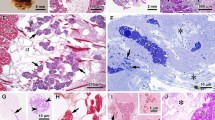Summary
-
1.
Electron micrographs of the ultimobranchial body in sexually mature Rana pipiens were prepared to describe the cytology of the parenchymal cells.
-
2.
Cytoplasmic granules, enclosed within a limiting membrane, are approximately 1000 Å in diameter and are found at the apical and basal poles of the nucleus as aggregations and also in the basal cytoplasm in contact with the basal plasma membrane.
-
3.
Lamellar bodies (myelin figures) of various complexities are found in all cells but are more prevalent in degenerating cells. Those structures found in the central lumen are a part of the cellular debris.
-
4.
Lysosomes with densities similar to those of cytoplasmic granules suggest that some granules are not utilized.
-
5.
Ergastoplasm within the parenchyma is scarce. The cytoplasm contains smooth membrane vesicles and free ribonucleoprotein (RNP) particles.
-
6.
The ultimobranchial body is considered to have a low rate of protein synthesis. The degree of endocrine activity, if any, could not be determined at this time.
Similar content being viewed by others
Literature
Bertmar, G.: Are the accessory branchial organs in Characidean fishes modified fifth gills or rudimentary ultimobranchial bodies? Acta zool. 42, 151–162 (1961).
Cecio, A.: Electron microscopic observations of young rat liver. I. Distribution and structure of the myelin figures (Lamellar bodies). Z. Zellforsch. 62, 717–742 (1964).
Distefano, H., and R. Dougherty: Virus particles in the nerve of Remark of chick embryos. J. nat. Cancer Inst. 33, 921–934 (1964).
Dudley, J.: The development of the ultimobranchial body of the fowl, Gallus domesticus. Amer. J. Anat. 71, 65–97 (1942).
Eggert, B.: Der ultimobranchiale Körper. Endokrinologie 20, 1–7 (1938).
Euler, U.S. von: Chromaffin cell hormones. In: Comparative Endocrinology, Ed. U.S. von Euler and H. Heller, vol. 1, p. 258–290 Academic Press New York 1963.
Freeman, J.A., and B.O. Spurlock: A new epoxy embedment for electron microscopy. J. Cell Biol. 13, 437–443 (1962).
Klapper, C.E.: The development of the pharynx of the Guinea-pig with special emphasis on the fate of the ultimobranchial body. Amer. J. Anat. 79, 361–397 (1946).
Maurer, F.: Schilddrüse, Thymus und Kiemenreste der Amphibien. Morph. Jb. 13, 297–382 (1888).
Menefee, M., and V. Evans: Structural differences produced in mammalian cells by changes in their environment. J. nat. Cancer Inst. 25, 1303–1323 (1960).
Munger, B.L.: The mode of secretion of alpha granules of pancreatic islet alpha cells. Anat. Rec. 139, 258 (1961) (Abstract).
—: The morphological sequence of secretion in the parathyroid glands as compared to other endocrine organs. Anat. Rec. 142, 261 (1962) (Abstract).
Ortmann, R.: Neurosecretion. In: Handbook of Physiology, Section 1, Neurophysiology, vol. II, p. 1039–1065. Washington, D.C.: American Physiological Society 1960.
Palay, S.L.: In: Ultrastructure and Cellular Chemistry of Neural Tissue, Ed. H. Waelsch, p. 31–44. London: Cassell 1957.
Rasquin, P., and L. Rosenbloom: Endocrine imbalance and tissue hyperplasia in teleosts maintained in darkness. Amer. Mus. Nat. Hist. 104, Article 4 (1954).
Reynolds, E.S.: The use of lead citrate at high pH as an electron opaque stain in electron microscopy. J. Cell Biol. 17, 208 (1963).
Robertson, D. R., and G. Swartz: Observations on the ultimobranchial body in Rana pipiens. Anat. Rec. 148, 219–230 (1964).
—: Development of the ultimobranchial body in Pseudacris nigrita triseriata. Trans. Amer. micr. Soc. 83, 330–337 (1964a).
Rogers, W. M.: The fate of the ultimobranchial body in the white rat (Mus norvegicus albinus). Amer. J. Anat. 38, 349–375 (1927).
Sehe, C.: Radioautographic studies on the ultimobranchial body and thyroid gland in vertebrates: fishes and amphibians. Endocrinology 67, 674–684 (1960).
Watson, M.L.: Staining of tissue sections for electron microscopy with heavy metals. J. biophys. biochem. Cytol. 4, 475–478 (1958).
Yamada, E.: The fine structure of the gall bladder epithelium of the mouse. J. biophys. biochem. Cytol. 1, 445–458 (1955).
Author information
Authors and Affiliations
Additional information
This project was supported in part by the National Institutes of Health, Grant No. 3 TI GM 326-05.
Rights and permissions
About this article
Cite this article
Robertson, D.R., Bell, A.L. The ultimobranchial body in Rana pipiens. Zeitschrift für Zellforschung 66, 118–129 (1965). https://doi.org/10.1007/BF00339321
Received:
Issue Date:
DOI: https://doi.org/10.1007/BF00339321




